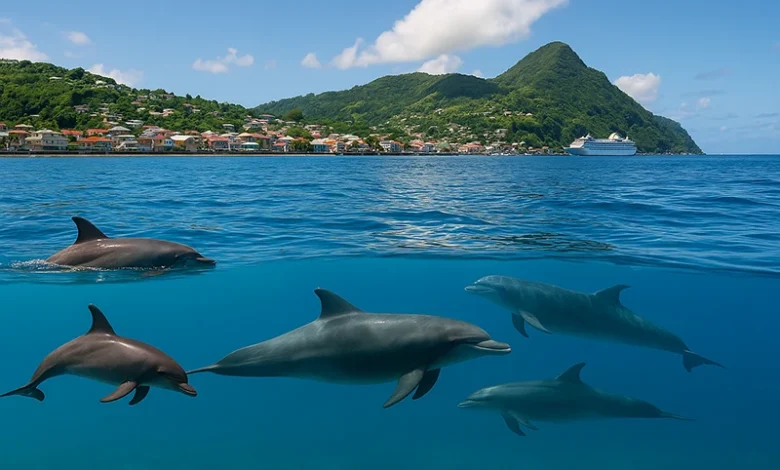Dolphins of Dominica: Species & Facts

Dolphins of Dominica are among the most captivating marine mammals seen off the coast of the Nature Isle. Dominica provides a perfect environment for resident and migratory dolphins with its deep ocean shelves, warm tropical waters, and protected areas. Their playful behaviors, social structures, and vocal intelligence make them favorites among marine watchers, researchers, and eco-tourism operators. These animals also contribute directly to the island’s vibrant marine tourism and its growing emphasis on sustainable tourism and ecotourism.
Dolphin Diversity in Dominica
The waters surrounding Dominica support a diverse range of dolphin species, many of which are regularly observed during whale watching and boating tours originating in coastal communities like Portsmouth, Soufrière, and Scotts Head. These dolphins are vital to the island’s Marine Biodiversity and help maintain balance in Dominica’s Marine Ecosystems.
Commonly Observed Dolphin Species
- Pantropical Spotted Dolphins (Stenella attenuata) are agile and social, often traveling in large pods and displaying high-energy leaps and bow-riding behaviors. Their distinctive speckled patterns develop with age.
- Spinner Dolphins (Stenella longirostris) are named for their incredible acrobatic spins. They are most active at dawn and dusk and are typically seen in large pods, sometimes hundreds strong.
- Common Bottlenose Dolphins (Tursiops truncatus) are well-known for their intelligence and frequent interactions with tour boats. Often found nearshore, these dolphins are curious, robust, and easily recognizable.
- Fraser’s Dolphins (Lagenodelphis hosei) prefer deep offshore waters and travel in large, tight-knit groups. They feature short beaks and a striking lateral stripe, though they are less frequently observed than other species.
- Striped Dolphins (Stenella coeruleoalba) are swift and sleek, sporting blue-black stripes along their flanks. They are energetic swimmers often seen in deeper offshore areas.
- Atlantic Spotted Dolphins (Stenella frontalis) are mid-sized, social dolphins covered in spots that become more visible with age. They are common in both shallow and offshore waters and exhibit a range of vocalizations.
- Clymene Dolphins (Stenella clymene) are smaller and rarer, known for their hybrid origin and their preference for deep offshore waters. They are acrobatic and typically move in mid-sized groups.
- Rough-toothed Dolphins (Steno bredanensis) have a distinct sloping forehead and a long, narrow snout. Found offshore, these dolphins are less studied but occasionally spotted during deep-water expeditions.
- Risso’s Dolphins (Grampus griseus) are notable for their scarred, pale-grey bodies and bulbous heads. Although less common around Dominica, they have been sighted farther from shore.
- Short-beaked Common Dolphins (Delphinus delphis) are among the most colorful and agile, with an hourglass pattern on their sides. They are seen occasionally in offshore pods, often mixed with other dolphin species.
Watching Dolphins and Marine Tourism
Dolphin watching in their natural environment is one of Dominica’s most popular and fulfilling marine activities. Tours often depart from towns like Roseau and Portsmouth, where the sea drops off rapidly, providing immediate access to deep-water dolphin habitats.
The island’s diving spots and snorkelling experiences are sometimes enhanced by unexpected dolphin sightings, especially in areas near the Soufrière Scotts Head Marine Reserve and waters close to the Sperm Whale Reserve. These encounters not only support tourism but also serve as vital educational tools that connect visitors with the island’s broader tourism industry and dominica economy.
Operators are trained and licensed under the Government of Dominica, adhering to protocols set by the Ministry of Tourism, Discover Dominica Authority, and the Wildlife and Parks Division. These rules ensure respectful dolphin viewing, protecting the animals while supporting livelihoods in coastal villages.
Conservation, Research, and Climate Pressures
Dominica’s dolphins enjoy relatively safe waters, thanks to national protections and community respect for marine life. But growing global pressures such as climate change, pollution, and plastic waste still pose significant threats.
Dolphins are vulnerable to changes in ocean temperature that affect their food sources, as well as acoustic disturbance from increased boat traffic. Ingested plastics and chemical runoff further impact their health and reproductive success.
Scientific and community-based efforts, including partnerships with organizations such as the Caribbean Cetacean Society, the International Whaling Commission, and regional NGOs, are vital in monitoring and conserving dolphin populations. Conservationists also work with schools and tour operators to promote awareness, ethical marine practices, and long-term protection of marine reserves.
Dolphins and Marine Ecosystems
Dolphins are apex indicators of ocean health. Their movement, foraging patterns, and social behavior play essential roles in maintaining the integrity of marine ecosystems. Predators of fish and squid, they help regulate prey populations and their travel often coincides with oceanic upwelling zones that boost biodiversity.
By protecting dolphin populations, Dominica not only preserves one of its most charismatic species but also enhances the sustainability of its fishing sector, boating, swimming, and marine recreation economy.




